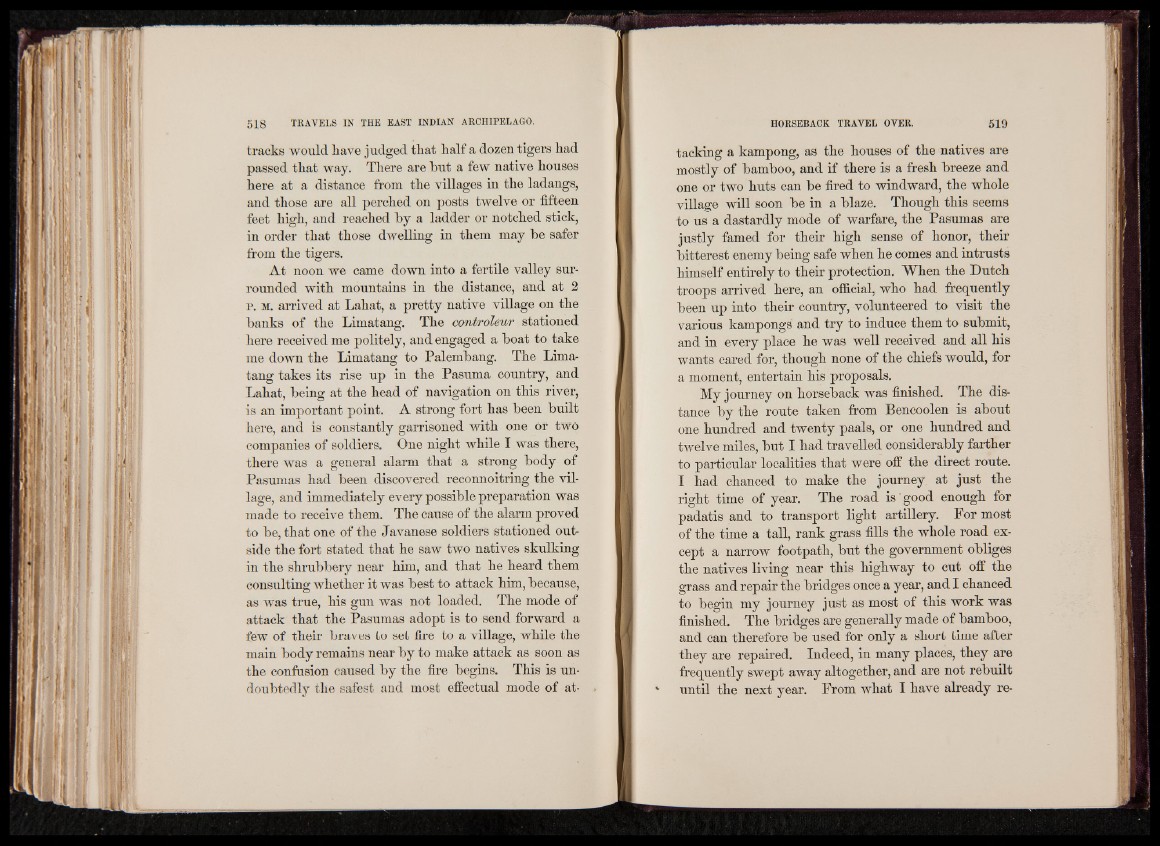
tracks would have judged that half a dozen tigers had
passed that way. There are but a few native houses
here at a distance from the villages in the ladangs,
and those are all perched on posts twelve or fifteen
feet high, and reached by a ladder or notched stick,
in order that those dwelling in them may be safer
from the tigers.
At noon we came down into a fertile valley surrounded
with mountains in the distance, and at 2
p. m. arrived at Lahat, a pretty native village on the
banks of the Limatang. The cont/roleur stationed
here received me politely, and engaged a boat to take
me down the Limatang to Palembang. The Limatang
takes its rise up in the Pasuma country, and
Lahat, being at the head of navigation on this river,
is an important point. A strong fort has been built
here, and is constantly garrisoned with one or two
companies of soldiers. One night while I was there,
there was a general alarm that a strong body of
Pasumas had been discovered reconnoitring the village,
and immediately every possible preparation was
made to receive them. The cause of the alarm proved
to be, that one of the Javanese soldiers stationed outside
the fort stated that he saw two natives skulking
in the shrubbery near him, and that he heard them
consulting whether it was best to attack him, because,
as was true, his gun was not loaded. The mode of
attack that the Pasumas adopt is to send forward a
few of their braves to set fire to a village, while the
main body remains near by to make attack as soon as
the confusion caused by the fire begins. This is undoubtedly
the safest and most effectual mode of attacking
a kampong, as the houses of the natives are
mostly of bamboo, and if there is a fresh breeze and
one or two huts can be fired to windward, the whole
village will soon be in a blaze. Though this seems
to us a dastardly mode of warfare, the Pasumas are
justly famed for their high sense of honor, their
bitterest enemy being safe when he comes and intrusts
himself entirely to their protection. When the Dutch
troops arrived here, an official, who had frequently
been up into their country, volunteered to visit the
various kampongs and try to induce them to submit,
and in every place he was well received and all his
wants cared for, though none of the chiefs would, for
a moment, entertain his proposals.
My journey on horseback was finished. The distance
by the route taken from Bencoolen is about
one hundred and twenty paals, or one hundred and
twelve miles, but I had travelled considerably farther
to particular localities that were off the direct route.
I had chanced to make the journey at just the
right time of year. The road is good enough for
padatis and to transport light artillery. For most
of the time a tall, rank grass fills the whole road except
a narrow footpath, but the government obliges
the natives living near this highway to cut off the
grass and repair the bridges once a year, and I chanced
to begin my journey just as most of this work was
finished. The bridges are generally made of bamboo,
and can therefore be used for only a short time after
they are repaired. Indeed, in many places, they are
frequently swept away altogether, and are not rebuilt
until the next year. From what I have already re